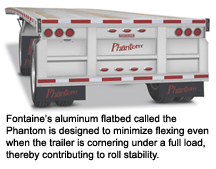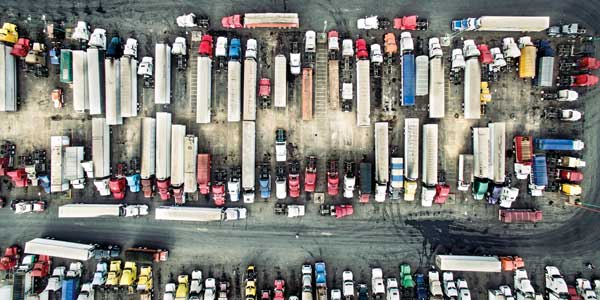High tech? Some van trailers and certainly many reefers are.
Low tech? That dubious honor has to be assigned to platform trailers. Tankers, on an average, probably lie somewhere in the middle even though some of these –– cryogenic trailers come to mind –– are very sophisticated. But even the most basic trailers often incorporate some very advanced products or designs.

For example, Transcraft engineers were able to increase the legal payload capacity of the company’s standard duty flatbed models by 8,000 lbs., fully 12 percent. According to Dave de Poincy, the company’s vice president and general manager, this was achieved through focused engineering efforts and the use of higher-strength materials. Since many flatbed operations are weight limited, this advance translates directly into revenue by allowing an extra four tons to be carried on a given dispatch.
Transcraft is certainly not the only trailer builder to introduce new products that utilize recently developed technologies. Utility Trailers very recently introduced its 4000A flatbed featuring an aluminum/ steel composite design, which the company describes as being both stronger and more durable than its model 2000A. Yet its engineers were able to deliver the product with tare weight reduction of more than 400 lbs. compared to the 2000A, which was the lightest flatbed the company had ever produced. The company is using the same one-piece main beam webs in the 4000A as are used in the 2000A but have incorporated a newly designed hat-shaped top flange into it. The main beams are contoured at the rear to facilitate uniform axle loading. A significant part of the weight savings comes from the use of a Hendrickson narrow-hanger AANT 23k spread air-ride suspension. Craig Bennett, senior vice president of sales and marketing for Utility, says, "With fuel costs and operating demands rising, this new model offers operators a fuel-efficient and durable alternative to other lightweight flatbeds."
Hank Prochazka, Fontaine Trailer’s vice president of sales, says, “Everyone wants to take weight and cost out of flatbed trailers, but we’re always up against durability, stability and maintenance issues every time we do that.” In spite of such challenges, Fontaine introduced a new light-weight flatbed earlier this year with some very unusual features. Called the Phantom, the new aluminum unit can handle 73,000 lbs. in just four feet or 70,000 lbs. in two feet –– a perfect design for steel coil haulers. Its main beam is made from extruded aluminum to eliminate welding between the web and the flange. A 12-in. flange, integral to the main beam, minimizes flexing even when the trailer is cornering under a full load, thereby contributing to roll stability. An integrated load securement system makes for easy loading and unloading, so provides the possibility of improved productivity.
Prochazka says that fully 75 percent of the company’s flatbed or drop deck trailers are equipped with air suspensions. The Phantom is no exception. Like Utility’s 4000A, the Phantom is equipped with the new Hendrickson AANT system, which uses a larger diameter but thinner walled axle than industry standard 5-in. designs. As a result, Hendrickson engineers were able to shave 50 lbs. out of each axle while increasing bending stiffness by 14 percent resulting in less deflection under load. Weighing in at only 490 lbs. for a standard configuration, it certainly looks like a good choice for design engineers who want to take some weight out of a flatbed or liquid tanker trailer.
“In recent years, we’ve taken advantage of high-strength low-alloy steel as well as replacing steel with aluminum components. But there’s usually a price to pay for taking weight out,” says Roger Roach, engineering project manager for platform trailers at Great Dane. “Yet a lot of these premium features are regularly spec’ed items by many fleets because of their particular operations. Trailer weight is critical to some fleets but not important to others. It depends on the operation.”
Wide base single tires
One might think that the weight saving potential offered by wide base singles would make the use of these tires a natural choice for flatbed operators concerned with trailer weight, but that has not been the case. It certainly has been for many liquid tank operators who get the added benefit of improved roll stability resulting from a lower center of gravity.
The reluctance may well result from the reports of unacceptable tread wear experienced by using these tires in the spread axle configurations so popular with flatbed fleets. Tire manufacturers, however, have developed tread designs for such applications that Great Dane’s Roach reports are performing quite well.
Keith Monroe, sales director at Great Dane, says, “We have one fleet that’s completely on wide base single tires –– all on spread axles. Because of that fleet, it would look like these tires are a large part of our business, but if you took out that fleet the use of wide base single tires would be almost nonexistent.”
Fifth wheels
While fifth wheels are not part of the trailer, there would be no road transport industry as we know it without one on each tractor. New technologies are also making improved designs possible in this all-important component. SAF-HOLLAND and Alcoa have partnered to produce what is likely the world’s lightest standard-duty fifth wheel. When used with the company’s ILS slider, the FWAL series aluminum fifth wheel saves up to 125 lbs. compared to competitive models. It comes with a five-year performance guarantee, meaning it will require no insert or lock jaw replacement for the period.
The new Holland aluminum fifth wheel is designed for standard-duty applications and forged from the same aluminum alloy as Alcoa’s aluminum truck wheels. It’s rated for 55,000 lbs. maximum vertical load and 150,000 lbs. maximum drawbar pull. The new fifth wheel utilizes the company’s NoLube technology that eliminates the use of grease on the top plate, between top plate and bracket, as well as in the lock mechanism. The technology can reduce maintenance time, decrease grease in the maintenance shop and the environment helping fleet managers comply with EPA regulations and save on steer tire wear.
Lighting
If you haven’t made the switch to LED lighting on your trailers because of initial price, now is the time to at least consider them on your next RFP. Remember that incandescent lamps generate both heat and light. Unfortunately, they have always converted more energy into heat than into light. LEDs are far more efficient and consume only a fraction of the energy required by incandescents to produce effective lighting. And prices are coming down. There are a number of economic forces driving down the cost of LED lighting products. Major among them are increased competition among suppliers, increased sales volume resulting in lower production costs as manufacturing output increases and manufacturers are getting higher yields out of their processes.
At the same time, the products continue to improve. New LEDs generate more light per unit of consumed power than earlier products. Brad Van Riper, senior vice president and chief technology officer at Truck-Lite, tells us of Haitz’s Law. Haitz was a researcher on LED technology at Hewlett Packard. The law named in his honor says that every 18 to 24 months there will be a doubling of the output of LEDs. Van Riper says, “This should continue for the next three to five years.”
There’s a little known but interesting characteristic of LEDs. Individually, they produce only one color. That is, a red LED produces only the frequency of red light. A blue LED produces only the frequency of blue light. Now remember from high school that white light is made up of a combination of all light frequencies. So how do we get white light out of an LED? The answer is through the use of chemical coatings similar to those used in fluorescent lights.
And a great deal of progress has been made on these R&D projects –– so much so that suppliers are now marketing LED work lamps, often used in both flatbed and tanker operations, that are said to be superior to incandescent products.
Truck-Lite recently introduced its 81 Series LED Work Lamp that comes to full brightness much sooner than incandescent versions. The lamp’s intensity and pattern is described as superior to that of a conventional incandescent work lamp in all respects. It is designed to operate in a 12V environment, but will function at full brightness from 8.5V to 16V, drawing only 1.2 amps compared to the incandescent 2.93 amp draw. With a 100,000 hour lamp life, the unit’s six diodes are encapsulated in epoxy for protection against moisture and corrosion.
Very recently, Grote Industries introduced its Trilliant LED work lamp, which rivals high intensity discharge lamps and eclipses halogen competitors. The Trilliant LED work lamp provides bright white light for more than 35,000 hours of operation compared to only 2,000 hours for HID and 500 with halogen lights.
“Trilliant LED work lamps save money because they have a long life. A long life means less downtime, lower repair costs and better workforce productivity. This type of lighting provides a safe, intelligently lit work area that reduces operator fatigue and enables better overall performance.” added Dominic Grote, vice president of sales and marketing for Grote Industries.
New technologies
What about all those high tech systems that we hear being used on some vans and reefer trailers? Are they migrating over to some platform designs? With very few exceptions, the answer is no. There is, however, a growing interest in onboard tire inflation systems. Fontaine’s Prochazka says, “There is a heavy gravitation of fleets toward the use of onboard inflation systems. They quickly pay for themselves in fuel economy and better tire wear.”
Great Dane’s Roach echoes this saying, “The use of tire inflation systems is growing every year but is generally confined to the larger fleets probably because they have a better handle on their tire costs than smaller operators.”
Because of the heavy concentrated loads often carried by flatbed operators, it’s surprising that these fleets don’t have a better interest in roll stability systems. Roach tells us, “Only a few fleets have so far specified roll stability system on platform trailers to any extent. Other fleets are trying them out on a very limited test basis.” Great Dane’s sales director, Keith Monroe says, “Carriers involved with carrying large steel coils are the ones interested in stability systems.”
While platform trailer operators usually don’t need the high tech systems that benefit other fleets, new technologies and innovative designs are providing fleets advantages not available on older trailer designs.


